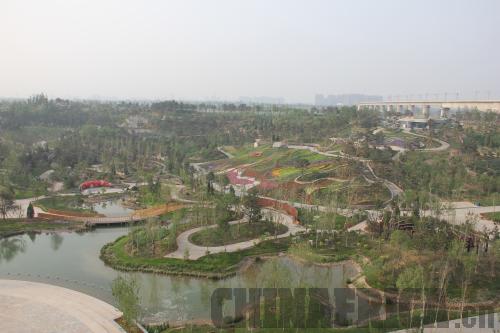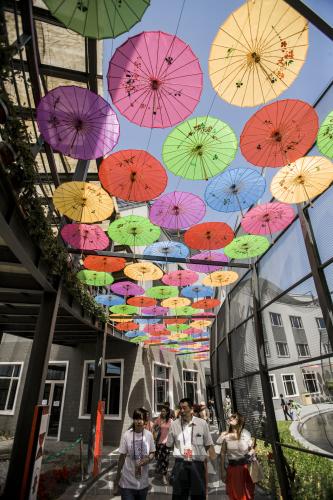|
 |
|
Splendid Valley (NI YANSHUO) |
Li Dong could not hide her surprise when she returned to her hometown from California. Having been away for four years, she was amazed by the transformation that Dongheyan Village, located near the Yongding River in southwest Beijing's Fengtai District, had undergone.
"I could not believe my eyes when I first came back here. You would feel the same if you knew what this place was like before," she told ChinAfrica.
Li's hometown has been transformed into a massive scenic park, where the Ninth China (Beijing) International Garden Expo (Beijing Garden Expo) is being held from May 18 to November 18, 2013. Inside the park, a variety of gardens, including some in European and African styles, can be seen in a colorful profusion of flowers, trees, shrubs and water features.
"It was amazing to see all the amazing landscapes here. You know, when I left here four years ago, this place was full of garbage," said Li, who was particularly impressed by the changes in the Splendid Valley area.
Li still recalls how garbage and sand used to fly around the area when the wind blew. "But now, people have a totally different view in the same place," she said, already on her fourth visit to the Garden Expo within 10 days of its opening to the public.
 |
|
Visitors stroll beneath paper umbrellas in the Beijing Garden Expo's Taiwan Garden on May 25 (WANG XIANG) |
A dramatic change
Li is not the only person pleased by the great changes in the Splendid Valley area. Zhang Jianhua, Director of the Beijing Garden Expo's Media Service Department, is equally proud of the developments.
"We have turned a foul and rotten area into a beautiful place. I hope this can serve as an example in terms of how to improve ecological environments in China," Zhang told ChinAfrica.
According to Duan Muqi, one of the designers who worked on the Beijing Garden Expo, Splendid Valley was the expo's greatest challenge in terms of design and construction. "This was a big pit about 30 meters deep, covering 24.3 hectares, and filled with garbage, so we had to take into consideration the special landforms in different places to make them into parts of the landscape," he said.
After careful research, Duan and his colleagues came up with a plan to make a sunken garden surrounded with rock features and waterfalls. "More importantly, we used waterproofing technology to prevent garbage pollutants from spreading," he said.
Workers first put waterproofing materials on the pit surface and then added soil and water to restore its basic ecological environment. After this, suitable plants were selected to grow in the valley.
"The construction of Splendid Valley is an excellent example of combining ecological restoration with an environmental upgrade," said Li Jinlong, a professor at Peking University's College of Environmental Sciences and Engineering, adding that the project can lend experience of ecological restoration to other places.
The work done for the Beijing Garden Expo is not the first time that a wasteland was transformed into a garden in China. Shanghai Chenshan Botanical Garden, which was opened to the public in 2011, was constructed on a deserted mine. After its ecology was restored and pollution prevention measures were put in place, its original mining pits, waste water pools and cliffs were renovated into a distinctive landscape. Today, it is the botanical garden with the most diversified plants in east China.
|